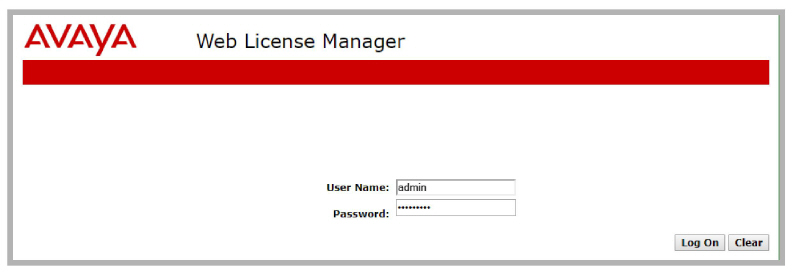
Installing the WebLM License and Server
The Web License Manager (WebLM) is a standard way of implementing feature licensing across various Avaya products. The WebLM program administers your Messaging license, providing access to all of the mailboxes and features that you are entitled to. If the connection to the WebLM server is interrupted, then Messaging will revert to demo mode after a grace period (see here).
Before installing Avaya IX Messaging onto the voice server, the site administrator must designate another computer to act as the license server, and then load the Web License Manager software onto that machine.
Refer to the Avaya WebLM documentation for the latest server specifications.
Configuring Web License Manager
1.On the computer designated as the license server, install the WebLM program according to the Avaya documentation.
2.When finished, launch the Web License Manager and login using administrator credentials.

3.Go to the Server properties tab and record the Primary Host ID. This is used to generate an XML license file specific to this machine.
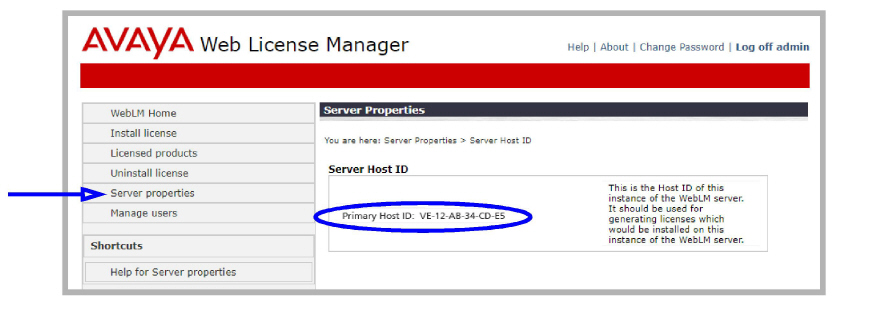
4.Send the Host ID to your vendor, and they will provide the license XML file for your program.
5.Return to WebLM and go to the Install License tab.
Enable the Accept License Agreement button.
Select Choose file, locate the license XML file on your computer and click Install.
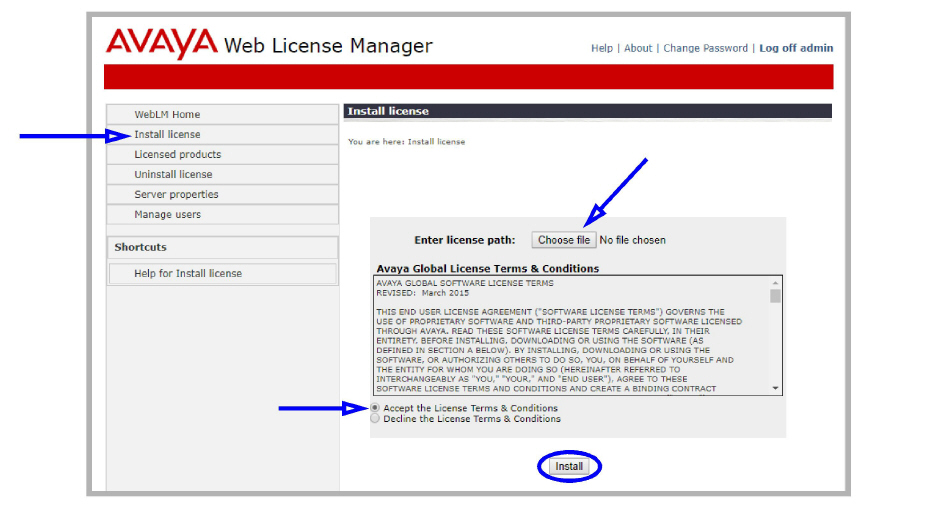
6.Once the license has been installed, you can verify the details of your license from the
Licensed products > IXM > IXM > View License Capacity tab.

7.Record the IP Address for this machine. This is used when installing the license in Messaging.
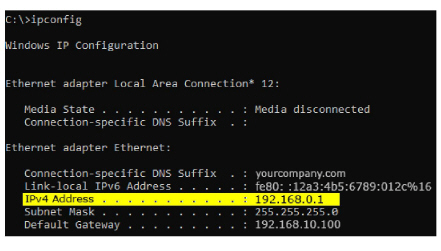
Installing the Messaging License
During the standard installation procedure, when you reach the License Type selection screen:
1. Choose Web LM as the license type.
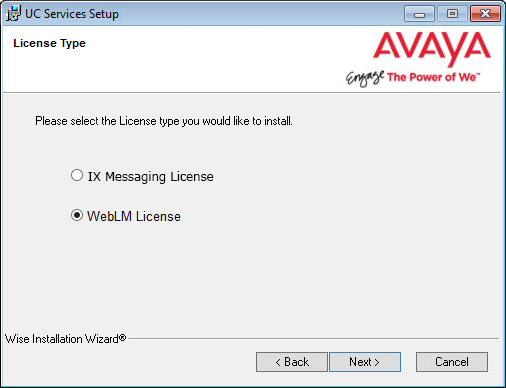
2.At the prompt, enter the IP address for the server configured in step 7 above. When ready, click OK.
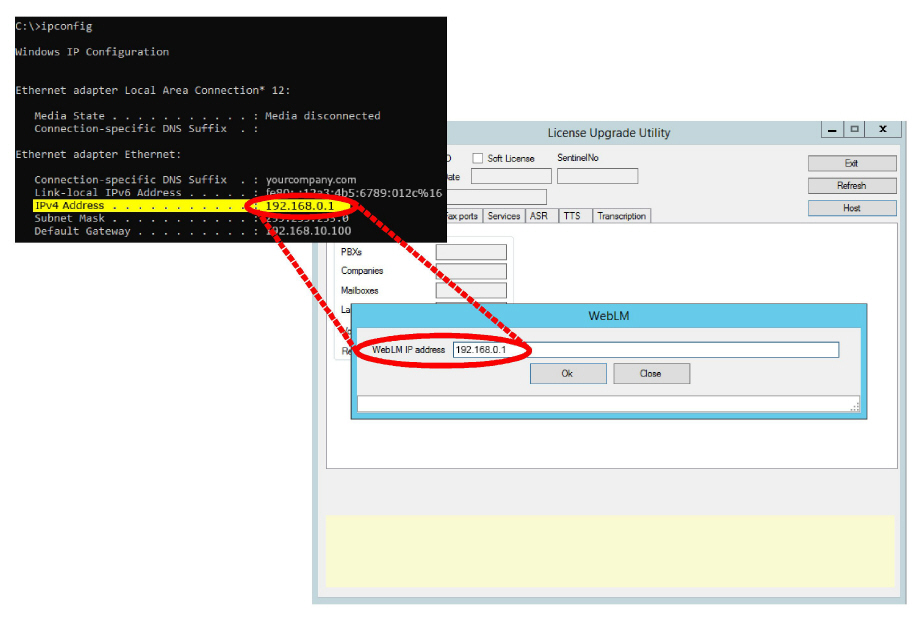
|
Hint: You can close and exit the installation at any time, although the program will operate in demo mode until a license is applied. To add the license information at a later time, or to modify your license with new features, go to Start > IX Messaging > UCLicenseWebLM and enter the details. 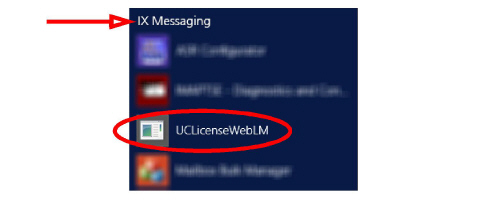
This menu item will only appear if you are using the WebLM license option. |
3.The license screen will be populated by the details shown is step 6.
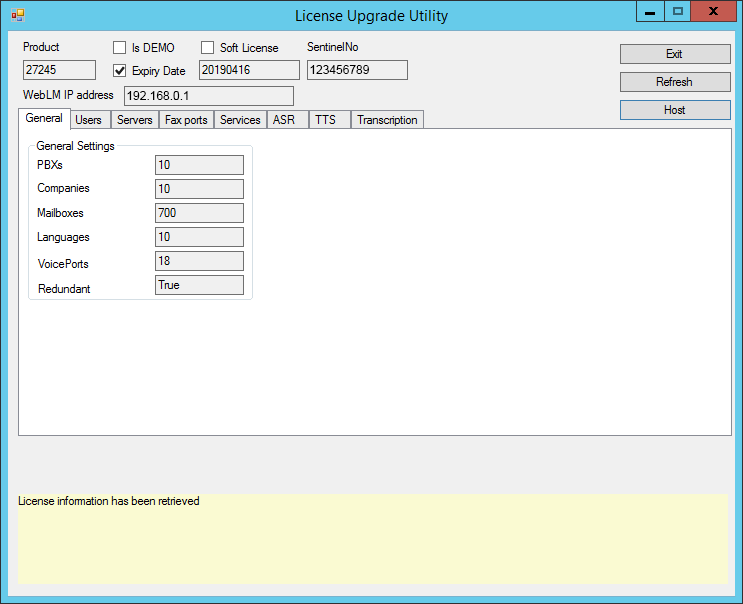
4.Return to the appropriate installation chapter and step to complete the installation.
Avaya IX Messaging program authorization is managed through a “soft” license. Activation of the program features and capacity (mailboxes) requires an connection to the license server. Messaging will periodically contact the license server to enable continued use of the program at the appropriate service level. If the connection is lost for a long enough period, then the software will fall into Demo Mode until the connection is re-established.
During the initial installation, the administrator will upload the license XML file onto the license server.
After the initial installation, if the license server hardware changes (i.e. the program has been moved to a new server), Messaging will immediately revert to Demo Mode. Contact customer service to reactivate the license.
Once Messaging has been installed and is operating, the program will contact the license server each day for authentication. In the case of a connection failure or other errors that prevent authorization, the program will continue to operate properly for 28 days. If the problems are not corrected and the connection re-established before then, the program will revert to Demo Mode. When errors with authentication do occur, the administrator will receive notifications from Messaging with details of the problem.
If the program detects that the license details are different between the Messaging and license servers, and no updates have been included, the system will immediately revert to Demo Mode until the issue can be resolved.
In the case where 2 computers are associated with the same license, only the first machine to be authenticated will receive the license. The second machine must wait up to 24 hours for authorization, and only if the first machine has relinquished the license.
Term based licenses last for a specific length of time. As the program nears its termination date, it will begin sending the administrator email reminders that the license is due to expire soon. These messages are sent at 90 days, 60 days, and 30 days prior to expiration. For the last 15 days, notifications will be sent out daily. If the license has not been renewed by the expiration date, the program will continue to operate, but at only 25% of its former capacity. For example, if there were 100 ports and 100 mailboxes licensed, there will now only be 25 ports and 25 mailboxes available on the system. This reduction lasts for 60 days, with reminders sent to the administrator each day, and then Messaging will fall into Demo Mode until a new license is purchased.
The program can be reactivated at any time once a new term has been purchased and the license is refreshed. Please make the necessary arrangements in plenty of time to avoid any disruptions in service.
In a High Availability (HA) installation, only the Primary connects to the license server. The Consolidated Server and all Secondary Servers get their licensing information from the Primary. Therefore, it is imperative that the Primary Server is the first one installed and operating because the other servers will install only the features appropriate to the license data they receive from the Primary.
The program can be put into Demo Mode for many reasons, such as the license expiring, or an extended loss of connection to license server.
Demo Mode maintains all licensed features, but operational capacity is reduce to a single port with 10 mailboxes. No data or settings are lost from the mailboxes, but there will be problems with access.
Messaging will continue to run in Demo Mode until the cause for the service reduction has been addressed (i.e. a new license is purchased, and fixing any connection problems).
|
Time Before Expiration |
Action Taken |
|---|---|
|
+90 days |
eMail Administrator |
|
+60 days |
eMail Administrator |
|
+30 days |
eMail Administrator |
|
+15 days to 0 days |
daily eMails to Administrator |
|
License Expires |
|
|
-1 day to -60 days |
Program capacity reduced to 25% |
|
-61 days and over |
Demo Mode |
Licensing Grace Periods and Actions
|
Condition |
Grace Period |
Action Taken after Grace Period |
|---|---|---|
|
Failure to authenticate license |
28 days |
Demo Mode |
|
Upgraded license not activated |
28 days |
Demo Mode |
|
Hardware changes |
- |
Demo Mode |
|
License Mismatch (not an upgrade) |
- |
Demo Mode |
In an HA installation, if the Primary server stops synchronizing with the Consolidated and Secondary servers (i.e. the Primary has gone offline or crashed), the connection must be re-established within 10 days before the system reverts to demo mode. If the Primary server remains connected to the Consolidated and Secondary servers, but cannot connect to the license server, then the Failure to authenticate license milestone is used (i.e. demo after 28 days).
|
Condition |
Grace Period |
Action Taken after Grace Period |
|---|---|---|
|
Primary Server fails to synch license with Consolidated and Secondary servers |
10 days |
Demo Mode |
|
Primary Server cannot connect to the license server. |
28 days |
Demo Mode |
MessagingMessagingMessaging